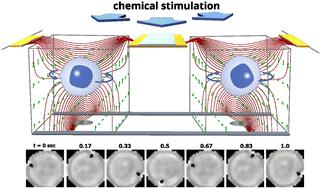Our official English website, www.x-mol.net, welcomes your
feedback! (Note: you will need to create a separate account there.)
Development of a simultaneous electrorotation device with microwells for monitoring the rotation rates of multiple single cells upon chemical stimulation
Lab on a Chip ( IF 6.1 ) Pub Date : 2022-11-07 , DOI: 10.1039/d2lc00627h Masato Suzuki 1, 2 , Shikiho Kawai 1 , Chean Fei Shee 3 , Ryoga Yamada 1 , Seiichi Uchida 3 , Tomoyuki Yasukawa 1, 2
Lab on a Chip ( IF 6.1 ) Pub Date : 2022-11-07 , DOI: 10.1039/d2lc00627h Masato Suzuki 1, 2 , Shikiho Kawai 1 , Chean Fei Shee 3 , Ryoga Yamada 1 , Seiichi Uchida 3 , Tomoyuki Yasukawa 1, 2
Affiliation

|
Here, we described a unique simultaneous electrorotation (ROT) device for monitoring the rotation rate of Jurkat cells via chemical stimulation without fluorescent labeling and an algorithm for estimating cell rotation rates. The device comprised two pairs of interdigitated array electrodes that were stacked orthogonally through a 20 μm-thick insulating layer with rectangular microwells. Four microelectrodes (two were patterned on the bottom of the microwells and the other two on the insulating layer) were arranged on each side of the rectangular microwells. The cells, which were trapped in the microwells, underwent ROT when AC voltages were applied to the four microelectrodes to generate a rotating electric field. These microwells maintained the cells even in fluid flows. Thereafter, the ROT rates of the trapped cells were estimated and monitored during the stimulation. We demonstrated the feasibility of estimating the chemical efficiency of cells by monitoring the ROT rates of the cells. After introducing a Jurkat cell suspension into the device, the cells were subjected to ROT by applying an AC signal. Further, the rotating cells were chemically stimulated by adding an ionomycin (a calcium ionophore)-containing aliquot. The ROT rate of the ionomycin-stimulated cells decreased gradually to 90% of the initial rate after 30 s. The ROT rate was reduced by an increase in membrane capacitance. Thus, our device enabled the simultaneous chemical stimulation-induced monitoring of the alterations in the membrane capacitances of many cells without fluorescent labeling.
中文翻译:

开发一种带微孔的同步电旋转装置,用于监测化学刺激下多个单细胞的旋转速率
在这里,我们描述了一种独特的同步电旋转 (ROT) 装置,用于通过以下方式监测 Jurkat 细胞的旋转速率没有荧光标记的化学刺激和估计细胞旋转速率的算法。该装置包括两对交叉指状阵列电极,它们通过带有矩形微孔的 20 μm 厚绝缘层正交堆叠。四个微电极(两个在微孔底部图案化,另外两个在绝缘层上)排列在矩形微孔的每一侧。当交流电压施加到四个微电极以产生旋转电场时,被困在微孔中的细胞会经历 ROT。即使在流体流动中,这些微孔也能维持细胞。此后,在刺激过程中估计和监测被困细胞的 ROT 率。我们证明了通过监测细胞的 ROT 速率来估计细胞化学效率的可行性。在将 Jurkat 细胞悬浮液引入设备后,通过施加交流信号对细胞进行 ROT。此外,旋转细胞通过添加含有离子霉素(钙离子载体)的等分试样进行化学刺激。离子霉素刺激细胞的 ROT 率在 30 秒后逐渐下降至初始速率的 90%。膜电容的增加降低了 ROT 速率。因此,我们的设备能够在没有荧光标记的情况下同时对许多细胞的膜电容变化进行化学刺激诱导监测。通过添加含有离子霉素(钙离子载体)的等分试样,对旋转细胞进行化学刺激。离子霉素刺激细胞的 ROT 率在 30 秒后逐渐下降至初始速率的 90%。膜电容的增加降低了 ROT 速率。因此,我们的设备能够在没有荧光标记的情况下同时对许多细胞的膜电容变化进行化学刺激诱导监测。通过添加含有离子霉素(钙离子载体)的等分试样,对旋转细胞进行化学刺激。离子霉素刺激细胞的 ROT 率在 30 秒后逐渐下降至初始速率的 90%。膜电容的增加降低了 ROT 速率。因此,我们的设备能够在没有荧光标记的情况下同时对许多细胞的膜电容变化进行化学刺激诱导监测。
更新日期:2022-11-07
中文翻译:

开发一种带微孔的同步电旋转装置,用于监测化学刺激下多个单细胞的旋转速率
在这里,我们描述了一种独特的同步电旋转 (ROT) 装置,用于通过以下方式监测 Jurkat 细胞的旋转速率没有荧光标记的化学刺激和估计细胞旋转速率的算法。该装置包括两对交叉指状阵列电极,它们通过带有矩形微孔的 20 μm 厚绝缘层正交堆叠。四个微电极(两个在微孔底部图案化,另外两个在绝缘层上)排列在矩形微孔的每一侧。当交流电压施加到四个微电极以产生旋转电场时,被困在微孔中的细胞会经历 ROT。即使在流体流动中,这些微孔也能维持细胞。此后,在刺激过程中估计和监测被困细胞的 ROT 率。我们证明了通过监测细胞的 ROT 速率来估计细胞化学效率的可行性。在将 Jurkat 细胞悬浮液引入设备后,通过施加交流信号对细胞进行 ROT。此外,旋转细胞通过添加含有离子霉素(钙离子载体)的等分试样进行化学刺激。离子霉素刺激细胞的 ROT 率在 30 秒后逐渐下降至初始速率的 90%。膜电容的增加降低了 ROT 速率。因此,我们的设备能够在没有荧光标记的情况下同时对许多细胞的膜电容变化进行化学刺激诱导监测。通过添加含有离子霉素(钙离子载体)的等分试样,对旋转细胞进行化学刺激。离子霉素刺激细胞的 ROT 率在 30 秒后逐渐下降至初始速率的 90%。膜电容的增加降低了 ROT 速率。因此,我们的设备能够在没有荧光标记的情况下同时对许多细胞的膜电容变化进行化学刺激诱导监测。通过添加含有离子霉素(钙离子载体)的等分试样,对旋转细胞进行化学刺激。离子霉素刺激细胞的 ROT 率在 30 秒后逐渐下降至初始速率的 90%。膜电容的增加降低了 ROT 速率。因此,我们的设备能够在没有荧光标记的情况下同时对许多细胞的膜电容变化进行化学刺激诱导监测。











































 京公网安备 11010802027423号
京公网安备 11010802027423号